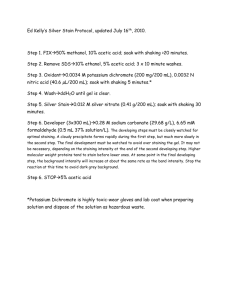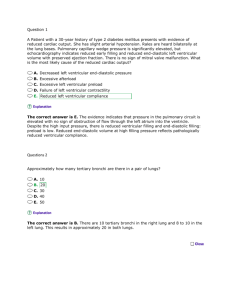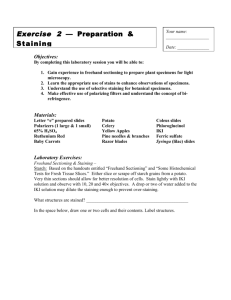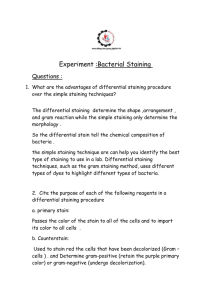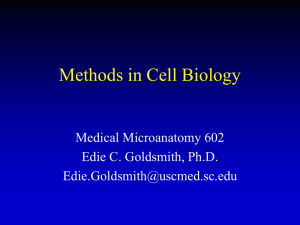Chapter 19 | On Chemical Reactions and Staining Mechanisms
advertisement
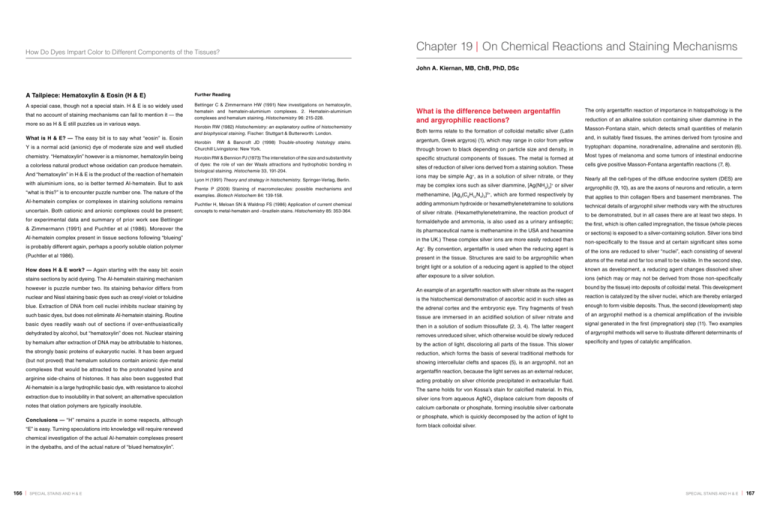
How Do Dyes Impart Color to Different Components of the Tissues? Chapter 19 | On Chemical Reactions and Staining Mechanisms John A. Kiernan, MB, ChB, PhD, DSc A Tailpiece: Hematoxylin & Eosin (H & E) Further Reading A special case, though not a special stain. H & E is so widely used ettinger C & Zimmermann HW (1991) New investigations on hematoxylin, B hematein and hematein-aluminium complexes. 2. Hematein-aluminium complexes and hemalum staining. Histochemistry 96: 215-228. that no account of staining mechanisms can fail to mention it — the more so as H & E still puzzles us in various ways. What is H & E? — The easy bit is to say what “eosin” is. Eosin Y is a normal acid (anionic) dye of moderate size and well studied chemistry. “Hematoxylin” however is a misnomer, hematoxylin being a colorless natural product whose oxidation can produce hematein. And “hematoxylin” in H & E is the product of the reaction of hematein Horobin RW (1982) Histochemistry: an explanatory outline of histochemistry and biophysical staining. Fischer: Stuttgart & Butterworth: London. Horobin RW & Bancroft JD (1998) Trouble-shooting histology stains. Churchill Livingstone: New York. Horobin RW & Bennion PJ (1973) The interrelation of the size and substantivity of dyes: the role of van der Waals attractions and hydrophobic bonding in biological staining. Histochemie 33, 191-204. What is the difference between argentaffin and argyrophilic reactions? Both terms relate to the formation of colloidal metallic silver (Latin argentum, Greek argyros) (1), which may range in color from yellow through brown to black depending on particle size and density, in specific structural components of tissues. The metal is formed at sites of reduction of silver ions derived from a staining solution. These The only argentaffin reaction of importance in histopathology is the reduction of an alkaline solution containing silver diammine in the Masson-Fontana stain, which detects small quantities of melanin and, in suitably fixed tissues, the amines derived from tyrosine and tryptophan: dopamine, noradrenaline, adrenaline and serotonin (6). Most types of melanoma and some tumors of intestinal endocrine cells give positive Masson-Fontana argentaffin reactions (7, 8). ions may be simple Ag+, as in a solution of silver nitrate, or they Nearly all the cell-types of the diffuse endocrine system (DES) are may be complex ions such as silver diammine, [Ag(NH3)2]+ or silver argyrophilic (9, 10), as are the axons of neurons and reticulin, a term methenamine, [Ag3(C6H12N4)2]3+, which are formed respectively by that applies to thin collagen fibers and basement membranes. The adding ammonium hydroxide or hexamethylenetetramine to solutions technical details of argyrophil silver methods vary with the structures of silver nitrate. (Hexamethylenetetramine, the reaction product of for experimental data and summary of prior work see Bettinger to be demonstrated, but in all cases there are at least two steps. In formaldehyde and ammonia, is also used as a urinary antiseptic; & Zimmermann (1991) and Puchtler et al (1986). Moreover the the first, which is often called impregnation, the tissue (whole pieces its pharmaceutical name is methenamine in the USA and hexamine Al-hematein complex present in tissue sections following “blueing” or sections) is exposed to a silver-containing solution. Silver ions bind in the UK.) These complex silver ions are more easily reduced than is probably different again, perhaps a poorly soluble olation polymer non-specifically to the tissue and at certain significant sites some Ag+. By convention, argentaffin is used when the reducing agent is (Puchtler et al 1986). of the ions are reduced to silver “nuclei”, each consisting of several present in the tissue. Structures are said to be argyrophilic when atoms of the metal and far too small to be visible. In the second step, bright light or a solution of a reducing agent is applied to the object known as development, a reducing agent changes dissolved silver after exposure to a silver solution. ions (which may or may not be derived from those non-specifically with aluminium ions, so is better termed Al-hematein. But to ask “what is this?” is to encounter puzzle number one. The nature of the Al-hematein complex or complexes in staining solutions remains uncertain. Both cationic and anionic complexes could be present; How does H & E work? — Again starting with the easy bit: eosin stains sections by acid dyeing. The Al-hematein staining mechanism Lyon H (1991) Theory and strategy in histochemistry. Springer-Verlag, Berlin. Prentø P (2009) Staining of macromolecules: possible mechanisms and examples. Biotech Histochem 84: 139-158. Puchtler H, Meloan SN & Waldrop FS (1986) Application of current chemical concepts to metal-hematein and –brazilein stains. Histochemistry 85: 353-364. however is puzzle number two. Its staining behavior differs from An example of an argentaffin reaction with silver nitrate as the reagent nuclear and Nissl staining basic dyes such as cresyl violet or toluidine is the histochemical demonstration of ascorbic acid in such sites as blue. Extraction of DNA from cell nuclei inhibits nuclear staining by the adrenal cortex and the embryonic eye. Tiny fragments of fresh such basic dyes, but does not eliminate Al-hematein staining. Routine tissue are immersed in an acidified solution of silver nitrate and basic dyes readily wash out of sections if over-enthusiastically then in a solution of sodium thiosulfate (2, 3, 4). The latter reagent dehydrated by alcohol, but “hematoxylin” does not. Nuclear staining removes unreduced silver, which otherwise would be slowly reduced by hemalum after extraction of DNA may be attributable to histones, by the action of light, discoloring all parts of the tissue. This slower the strongly basic proteins of eukaryotic nuclei. It has been argued reduction, which forms the basis of several traditional methods for (but not proved) that hemalum solutions contain anionic dye-metal showing intercellular clefts and spaces (5), is an argyrophil, not an complexes that would be attracted to the protonated lysine and argentaffin reaction, because the light serves as an external reducer, arginine side-chains of histones. It has also been suggested that acting probably on silver chloride precipitated in extracellular fluid. Al-hematein is a large hydrophilic basic dye, with resistance to alcohol The same holds for von Kossa’s stain for calcified material. In this, extraction due to insolubility in that solvent; an alternative speculation silver ions from aqueous AgNO3 displace calcium from deposits of notes that olation polymers are typically insoluble. Conclusions — “H” remains a puzzle in some respects, although “E” is easy. Turning speculations into knowledge will require renewed bound by the tissue) into deposits of colloidal metal. This development reaction is catalyzed by the silver nuclei, which are thereby enlarged enough to form visible deposits. Thus, the second (development) step of an argyrophil method is a chemical amplification of the invisible signal generated in the first (impregnation) step (11). Two examples of argyrophil methods will serve to illustrate different determinants of specificity and types of catalytic amplification. calcium carbonate or phosphate, forming insoluble silver carbonate or phosphate, which is quickly decomposed by the action of light to form black colloidal silver. chemical investigation of the actual Al-hematein complexes present in the dyebaths, and of the actual nature of “blued hematoxylin”. 166 | special stains and h & E special stains and H & E | 167 On Chemical Reactions and Staining Mechanisms On Chemical Reactions and Staining Mechanisms In the Grimelius technique, for showing cells of the diffuse endocrine References system (10), sections are impregnated with 0.004 M AgNO3 in 1.Shorter Oxford English Dictionary, 3rd ed. Oxford: Clarendon Press, 1973, pp. 102, 103. a 0.02 M acetate buffer at pH 5.6 for three hours at 60 °C. This solution has been found empirically to provide for nucleation of silver in and around the secretory granules of cells of the DES. The slides are then transferred to a 0.09 M solution of hydroquinone in 0.4 M sodium sulfite, in which they remain for one minute. Sulfite ions react with silver ions (partly derived from residual impregnating solution and partly from silver non-specifically bound to the tissue) to form a complex anion, [Ag(SO3)2] 3−. This is reduced by hydroquinone and the resulting black colloidal silver accumulates around the initially formed nuclei in the cytoplasms of cells of the DES. A negative result with this simple, inexpensive technique may avoid multiple expensive immunohistochemical tests for the various peptides and proteins that characterize different DES cell-types and tumors derived from them (8). There are several silver methods for reticulin that have in common three major steps (12). Gomori’s technique (13) is typical. The sections are treated for one minute with 0.06 M aqueous potassium permanganate. This oxidizes the neutral sugar components of glycoproteins to aldehyde groups. (Reticular fibers and basement membranes contain relatively more carbohydrate than larger collagen fibers.) Brown manganese dioxide is deposited all over the sections and is removed by rinsing in 0.09 M potassium metabisulfite. After washing well with distilled water the sections are placed for two minutes in an alkaline silver diammine solution (approximately 0.4 M total Ag). This reagent is reduced to metal by aldehydes and some 2. Bourne G. Vitamin C in the adrenal gland. Nature 1933;131:874. 3. Willis RJ, Kratzing CC. The chemistry of the silver precipitation method used for the histochemical localization of ascorbic acid. Stain Technol 1974;49(6):381-386. 4.Lam K-W, Zwaan J, Garcia A, Shields C. Experimental detection of ascorbic acid in the eye of the early chicken embryo by silver staining. Exp Eye Res 1993;56:601-604. 5.Lee AB. The Microtomist’s Vade-Mecum. A Handbook of the Methods of Microscopic Anatomy. London: Churchill, 1885, pp. 101-104. How does pH influence the staining mechanism of Schiff's reagent in biological tissue samples? Schiff’s reagent is a solution made by reaction of basic fuchsine, a red dye, with sulfurous acid. The reagent ideally is colorless, but it may be light yellow on account of impurities in the dye. It was introduced by Hugo Schiff in 1866 as a chromogenic test for aldehydes. Traditionally, basic fuchsine was a mixture of four cationic red triphenylmethane dyes (pararosaniline, rosaniline, magenta II and new fuchsine) made whereas products sold as basic fuchsine typically are mixtures (2, 3). All four components of basic fuchsine are suitable for making Schiff’s reagent, but pararosaniline has been the one used in chemical studies. Triphenylmethane dyes are commonly formulated as shown in Figure 1 (I - IV) with the positive charge on a nitrogen attached to a quinonoid ring, but other resonance forms are equally valid. The carbonium ion structure (V) allows for the simplest explanations of the formation and reactions of Schiff’s reagent. The balancing anions, not shown in Figure 1, may be chloride or acetate. 6.Lundqvist M, Arnberg H, Candell J, et al. Silver stains for identification of neuroendocrine cells. A study of the chemical background. Histochem J 1990;38:615-623. by oxidizing a crude mixture of aniline and mixed ortho- and para- The reaction with sulfurous acid (Fig. 1, V) decolorizes the dye. The isomers of toluidine (1). Pure aniline, p-toluidine and o-toluidine structure of the colorless product was debated for many years (4), 7. Grizzle WE. Theory and practice of silver staining in histopathology. J Histotechnol 1996;19(3):183-195. have been articles of commerce for many years. Consequently, but it is now generally agreed to be an alkylsulfonic acid as shown pararosaniline and new fuchsine are available as individual dyes, (for Schiff’s reagent made from pararosaniline) in Figure 1 (5, 6, 7). 8. Grizzle WE. Silver staining methods to identify cells of the dispersed neuroendocrine system. J Histotechnol 1996;19(3):225-234. 9. Montuenga LM, Guembe L, Burrell MA, et al. The diffuse endocrine system: from embryogenesis to carcinogenesis. Prog Histochem Cytochem 2003;38(2):155-272. 10. Grimelius L. Silver stains demonstrating neuroendocrine cells. Biotech Histochem 2004;79(1):37-44. 11. Gallyas F. Physicochemical mechanisms of histological silver staining and their utilization for rendering individual silver methods selective and reliable. Biotech Histochem 2008;83(5):221-238. 12.Lillie RD, Fullmer HM. Histopathologic Technic and Practical Histochemistry. 4th ed. New York: McGraw-Hill, 1976, pp. 683-692. 13. Garvey W. Some favorite silver stains. J Histotechnol 1996;19(3): 269-278. 14. Velican C, Velican D. Silver impregnation techniques for the histochemical analysis of basement membranes and reticular fiber networks. In: Glick D, Rosenblaum RM, eds. Techniques of Biochemical and Biophysical Morphology. v. 1. New York: Wiley, 1972: pp. 143-190. of the complex silver ions are nonspecifically bound to the tissue. After a brief rinse in water the slides are placed in 20% formalin (2.7 M formaldehyde) for 4 minutes. This reacts with residual and loosely bound silver diammine ions and the resulting silver is deposited preferentially upon the catalytic silver “nuclei” formed at the sites of aldehyde groups produced by the initial permanganate oxidation (14). Figure 1. The components of basic fuchsine (I - IV) and the formation of Schiff’s reagent by reaction of pararosaniline with sulfurous acid (V,VI). 168 | special stains and h & E special stains and H & E | 169 On Chemical Reactions and Staining Mechanisms Studies with NMR spectroscopy indicate that the major component On Chemical Reactions and Staining Mechanisms be stable while exposed to the air and losing sulfur dioxide for 15 now contains some regenerated basic fuchsine, which could bind to changes when slides are washed after immersion in Schiff’s reagent. is the zwitterionic form shown (VI) in which one of the amino groups to 20 minutes. Accordingly, Schiff’s reagent for use as a biological polyanions in the tissue and give false-positive staining in cartilage Rinses in 0.03 M sulphurous acid to remove unbound reagent were is protonated (6). stain must be acidic (pH about 2 is best for most applications) and it matrix, mast cell granules and other materials that are stainable by formerly commonplace (10, 11) but they weaken the final color. Rapid must contain more sulfurous acid than was needed to decolorize the cationic dyes at low pH. Reaction VI → V of Figure 2 is reversible, washing in water does not result in false-positive staining (12) and basic fuchsine. If the pH approaches 3 a white precipitate may form so Schiff’s reagent that has become pink from losing SO2 can be is currently recommended (9, 13). The rise in pH associated with of an excess of sulfurous acid. Raising the pH or reducing the after a few months of storage (4, 9). In equation VII it is seen that a regenerated by adding a source of sulfurous acid, such as thionyl washing in water for 10 minutes reduces the protonation of the stable concentration of sulfurous acid increases the sensitivity of the solution at pH 2 contains predominantly bisulphite ions and sulfurous chloride or sodium metabisulphite. Excessive acidification causes dye-tissue complex (X in Figure 2), with resultant intensification of reagent for detecting aldehydes but also leads to regeneration of the acid molecules. Reversal of the sulfonation, VI → V, occurs if there additional protonation, leading to the formation of IX, which does not the color. The same effect can be achieved in 15 seconds with 0.3% original dye. Some of the equilibria that account for this instability is loss of SO2 into the atmosphere (see VII) or if the pH is raised react with aldehydes (6, 8). sodium tetraborate, an alkaline solution (14). (6, 8) are summarized in Figure 2 (VII, V-VI). For histochemical towards neutrality. SO2 can escape from a loosely capped bottle. The purposes high sensitivity is not usually needed and the reagent must Schiff’s reagent then becomes pink and is unfit for use because it The colorless solution is stable only at low pH and in the presence The simplest (theoretically) and oldest way to make Schiff’s reagent is to bubble gaseous sulfur dioxide through a 0.3-1.0% (0.01-0.03M) aqueous solution of basic fuchsine. This is the method implied in Figure 2. The acidity of the solution is then due only to ionization of sulfurous acid (pK1 = 1.9) but it is almost impossible to adjust the amount of added SOCI2 in the range between the minimum needed to decolorize the dye and the maximum dictated by the solubility of SOCI2 gas in water.Another technique is to add some thionyl chloride, 1.Cooksey C, Dronsfield A. Fuchsine or magenta: the second most famous aniline dye. A short memoir on the 150th anniversary of the first commercial production of this well known dye. Biotech Histochem 2009;84(4):179-83. 2.Horobin RW, Kiernan JA, eds. Conn’s Biological Stains. A Handbook of Dyes, Stains and Fluorochromes for Use in Biology and Medicine. 10th ed. Oxford: BIOS, 2002, pp.184-186, 190-191. SOCl2, to the dye solution. This liquid reacts instantly with water: 3. Green FJ. The Sigma-Aldrich Handbook of Stains, Dyes and Indicators. Milwaukee, Wisconsin: Aldrich Chemical Company, 1990, pp. 126-130. SOCl2 + 2H2O H2SO3 + 2H+ + 2Cl− providing both sulfurous 4. Kasten, FH. The Chemistry of Schiff’s reagent. Int Rev Cytol 1960;10:1-100. and hydrochloric acids in a 1:2 molar ratio. Schiff reagents made 5.Hardonk MJ, van Duijn P. The mechanism of the Schiff reaction as studied with histochemical model systems. J Histochem Cytochem 1964;12(10):748-51. with thionyl chloride can be stored for a few years in securely capped bottles (4, 9). Probably the most popular recipes for Schiff’s reagent (4, 7, 10) are those in which the sulfurous acid is formed by dissolving sodium metabisulfite in the dye solution and then adding hydrochloric acid, allowing control of both the pH and sulfurous acid content as well as avoiding the use of more hazardous chemicals. Many vendors sell Schiff’s reagent as a ready-made solution. A survey of 20 material safety data sheets (MSDS) shows that all were made with sodium metabisulfite, bisulfite or sulfite (0.1-2.0%), and hydrochloric acid, with concentrations of basic fuchsine ranging from 0.01 to 1.0%. The pH was reported in only 6. Robins JH, Abrams GD, Pinock JA. The structure of Schiff reagent aldehyde adducts and the mechanism of the Schiff reaction as determined by nuclear magnetic resonance spectroscopy. Can J Chem 1980;58:339-47. 7.Pearse AGE, Stoward PJ. Histochemistry, Theoretical and Applied, 4th edn. Vol. 2. Analytical Technique. Edinburgh: Churchill-Livingstone, 1985 pp. 850-852. 8.Heinemann RL. Comparative spectroscopy of basic fuchsin, Schiff reagent, and a formalin-Schiff derivative in relation to dye structure and staining. Stain Technol 1970;45(4):165-72. 9. Kiernan JA. Histological and Histochemical Methods: Theory and Practice. 4th ed. Bloxham, UK: Scion, 2008, pp. 224-227, 293-296. seven of the MSDS, usually as a range such as 1.1-1.5 or 1.5-2.0. 10.Lillie RD, Fullmer HM. Histopathologic Technic and Practical Histochemistry. 4th ed. New York: McGraw-Hill, 1976, pp. 305-308. The two most frequent histochemical applications of Schiff’s reagent 11. McManus JFA, Mowry RW. Staining Methods. Histologic and Histochemical. New York: P. B. Hoeber, 1960 pp. 75, 126-128. are the periodic acid-Schiff (PAS) method for neutral mucosubstances and the Feulgen reaction, a specific stain for DNA. Investigations in the 1950s indicated that maximum staining intensity was achieved at pH 2.4 for the PAS method, whereas pH optima ranging from 2.3 to 4.3 Figure 2. Effects of pH on equilibria in solutions containing sulfite, bisulfite, sulfurous acid and sulfur dioxide (VII). Effects of H2SO3 and H+ on the protonation of Schiff’s were reported for the Feulgen technique (4). Current practice favors reagent (VI, VIII, IX) and on the product of reaction with tissue-bound aldehyde groups (X, XI). more acidic and therefore more stable solutions. The ambient pH 170 | special stains and h & E References 12.Demalsy P, Callebaut M. Plain water as a rinsing agent preferable to sulfurous acid after the Feulgen method. Stain Technol 1967;42:133-6. 13.Carson FL. Histotechnology. A Self-Instructional Text. 2nd ed. Chicago: American Society of Clinical Pathologists, 1997, p. 114. 14.Churukian CJ. Manual of the Special Stains Laboratory (2000 edition). Rochester, NY: University of Rochester Medical Center, 2000, pp. 52-55, 119-120; Also http://www.urmc.rochester.edu/path/zqu/ StainsManual/PERIODICACIDSCHIFFMETHOD.html (2009). special stains and H & E | 171 On Chemical Reactions and Staining Mechanisms What is Giemsa’s stain and how does it color blood cells, bacteria and chromosomes? On Chemical Reactions and Staining Mechanisms In most blood stains the anionic dye is eosin Y (tetrabromofluorescein), which is easily purified. The stains of Leishman and of Macneal have eosin B, which is often a mixture of related dyes. Stains for Blood Probably the first use of a staining solution containing methylene blue (a cationic thiazine dye) and eosin (a red anionic xanthene dye) was in 1888 by C. Chenzinsky, to stain malaria parasites in blood films. F. Plehn in 1890 and E. Malachowski and D. L. Romanowsky in 1891 all independently described similar staining solutions that imparted a variety of colors to erythrocytes, leukocytes and malaria parasites (1). Notably, leukocyte nuclei were purple and the parasite nuclei were bright red; these colors could not be obtained with any technique in which the two dyes were used sequentially (2). Romanowsky’s thesis (in Russian) and publication (in German) noted that the desired colors were obtained only when the methylene blue was derived from a stock Giemsa’s Formulation Gustav Giemsa (1867-1948) endeavored to produce mixtures of dyes that would reliably provide the Romanowsky color scheme (6). These formulations were published in 1902-1904, with the most advanced version being an aqueous solution containing a large excess of azure II over eosin Y. Azure II was a deliberate mixture of unoxidized methylene blue with azure I. Azure I was the name used at that time for the dye now called azure B. Modern formulations of Giemsa’s stain are made by mixing azure B eosinate with methylene blue and are commercially available as Giemsa powder, which is dissolved in solution old enough to have mold growing on its surface. The improved a 50/50 mixture of methanol and glycerol to provide a concentrated staining properties of “ripened” methylene blue solutions were studied stock solution (9). For staining, the stock solution is diluted in water that by Unna (3), who also published in 1891 and found that the aging is buffered to a pH appropriate to the intended application – pH 6.5- process could conveniently be accelerated by heat and alkalinity. 7.0 for alcohol-fixed blood films, lower for sections of formaldehyde- Artificially ripened or polychrome methylene blue was used by most fixed tissues (2). later inventors of blood stains, including L. Jenner (1899), B. Nocht (1899), W. Leishman (1901), R. May & L. Grunwald (1902), and J. Wright (1902) (1, 2). The products of polychroming, studied by Kehrmann (4) and later by Homes and French (5), result from demethylation of methylene blue and also from oxidation of the resulting dyes (Fig. 1). Dyes Needed for the Romanowsky-Giemsa Effect The compositions of blood stains were critically studied, using modern chromatographic and analytical methods, in the 1970s, notably by Paul Marshall in the UK (7, 8) and Dietrich Wittekind (2, 10) in Staining solutions made by mixing solutions of polychrome methylene Germany. These investigations revealed that the nuclear and all blue and eosin are unstable because the oppositely charged dye ions other colors constituting the “Romanowsky-Giemsa effect” could be combine to form salts, known as azure eosinates, that are insoluble in obtained with solutions containing only azure B and eosin Y. Pure water. Azure eosinates are soluble in alcohols – a mixture of methanol azure B, made by direct synthesis rather than from polychromed and glycerol is commonly used – and they dissolve in water in the methylene blue, has been commercially available (as chloride, presence of an excess of either thiazine dye or eosin. Furthermore, continued oxidation results in the deposition of other water-insoluble products such as methylene violet (Bernthsen) (Fig. 1). For the production of commercial blood stains the precipitated eosinate is collected and dried (6, 7). Blood stains devised after 1902, such as tetrafluoroborate or thiocyanate) since 1980 (11) and is used in a “Standardized Romanowsky-Giemsa method” (12) in which a stable methanolic solution of the eosinate is diluted with an aqueous buffer to make the working staining solution. Macneal’s “tetrachrome” (1922) and the formulation of Roe, Lillie & Pure azure B is more expensive than the crude variety, and there Wilcox (1941) made use of eosinates of azures A and B and methylene is still considerable demand for Giemsa’s, Wright’s, Macneal’s and blue. Later work showed that all commercially produced thiazine dyes related blood stains made from polychrome methylene blue and from were mixtures of the compounds shown in Figure 1, with the nominal impure azures A and B. The chemical compositions and staining dye sometimes not the most abundant component (6, 8). properties of these traditional mixtures have been shown to vary 172 | special stains and h & E Figure 1. Dyes present in Giemsa’s and other blood stains. The arrows indicate the progressive demethylation and oxidation that constitute polychroming of methylene blue. special stains and H & E | 173 On Chemical Reactions and Staining Mechanisms On Chemical Reactions and Staining Mechanisms Figure 2. Thin layer chromatography of certified commercial samples of azure B and Giemsa’s stain, on Unisil™ silica gel plates. Solutions in methanol were applied to the origin and development was in butanol-water-acetic acid for 120 minutes. Transcribed from cromatograms prepared by Mr Matthew Frank in the Biological Stain Commission’s laboratory, Rochester NY. Spots 3 and 4, both labeled azure A, probably represent azure A and its isomer sym-dimethylthionine respectively (7, 8). among different suppliers and even among different lots from the proteins are hemoglobin in erythrocytes and the major basic protein of same supplier (7, 8). In the USA, samples of batches of methylene eosinophil granules (17). The red coloration of malaria parasite nuclei blue, azures A, B and C, methylene violet (Bernthsen) and powders may be a due to a preponderance of basic proteins (histone) over for Giemsa’s Jenner’s and Wright’s stains are tested by the Biological DNA in the nuclei of protozoa (18, 19) and some invertebrates (20). Stain Commission (BSC) by assaying dye content, spectrophotometry, thin-layer and high performance liquid chromatography and use in standardized staining procedures (13). Satisfactory batches are certified, and each bottle of dye powder carries a small additional label, provided by the BSC, attesting to this fact. Certified dyes should always be used for preparing solutions of Romanowsky-Giemsa stains. Azure B, the single most important ingredient of these stains, does not have to be the ultra-pure directly synthesized dye to meet the BSC’s requirements for certification (Fig. 2). Giemsa for Tissue Sections The expected colors in cells of blood or bone marrow are seen only in alcohol-fixed films or smears and when the diluted staining mixture is close to neutrality - usually pH 6.8. Wright’s or Leishman’s stain is usually used, being allowed to act for about 3 minutes. Giemsa’s stain, which is much more stable when diluted, can be allowed to act for 15-45 minutes. After fixation with formaldehyde, which reacts with amino and other basic groups, nearly everything stains blue at pH 6.8. Paraffin sections can be stained with Giemsa at pH 4 to Staining Mechanisms 5. The sections show blue (not purple) nuclei, pink erythrocytes, Studies of the interaction of DNA with azure B (14, 15) indicate that cytoplasm and collagen, and metachromatic (red-purple) mast cells in solution the dye cations are present as dimers, each with the two and cartilage. The colors are not the same as those seen in alcohol- planar ring systems held together by van der Waals forces. The dimers fixed blood films (21-23). Giemsa is often used to stain bacteria in are attracted to the negatively charged phosphate groups of DNA and sections of formaldehyde-fixed gastric biopsies. The organisms are adhere to the macromolecule as a result of hydrophobic interactions dark blue against an unstained or light pink background (23). The with the purine and pyrimidine rings of the DNA bases. Attraction substrates of staining are presumably bacterial DNA and RNA, which of eosin anions by un-neutralized positive charges of bound azure differ from their animal counterparts in not being associated with basic B dimers changes the color of the stained DNA from blue to purple proteins (24). The teichoic acids of the cell walls of Gram-positive (16). Eosin is also attracted to proteins with excess protonated amino bacteria probably also bind cationic dyes, and the phosphate groups and guanidino groups (mainly side chains of lysine and arginine) over of lipopolysaccharides can be expected to have a similar role in Gram- ionized carboxy groups (mainly glutamic and aspartic acids); these negative organisms. 174 | special stains and h & E Figure 3. Karyogram of GTG-banded human chromosomes ( ) (46 chromosomes, including XY): GTG = G-banding with trypsin-Giemsa. Courtesy of Dr. Stefan Mueller, Ludwig-Maximilians-University, Munich, Germany. special stains and H & E | 175 Chapter 20 | H&E Staining On Chemical Reactions and Staining Mechanisms Gary W. Gill, CT(ASCP) Chromosome Banding Giemsa (G-banding) is the stain most commonly used to display transverse bands in mitotic (metaphase) chromosomes, having largely replaced quinacrine and other fluorochromes (Q-banding) that were formerly used for this purpose. There are various empirically developed G-banding techniques in which chromosome preparations – typically cell cultures that have been arrested in metaphase, spread onto slides, and fixed in 3:1 methanol-acetic acid – are subjected to pre-treatments before staining with Giemsa (25, 26). The dye cations in the Giemsa mixture (azure B and methylene blue) are attracted by the phosphate anions of DNA and are then held more closely by van der Waals forces to regions rich in adenine and thymine. Regions of a chromosome rich in guanine-cytosine pairs do not bind the blue dyes. The pretreatment determines the type of banding pattern. In typical G-banding the preparations are treated either with a sodium chloride and citrate solution at 60°C for one hour or with trypsin for 10 seconds at room temperature before staining in dilute Giemsa at pH 6.8 for 45 minutes (Fig. 3). R-banding is a method that shows bands that are complementary to the G-bands; that is, the dark and light regions of the G-banded chromosome are reversed. The pretreatment for R-banding is with 1.0 M NaH2PO4 (pH about 4) at 88°C for 20 minutes, and the staining is with a more concentrated Giemsa solution, for 10 minutes (27). G-banding is the method usually used for identifying chromosomes. R-banding is useful for showing the ends of chromosomes (telomeres). A variant known as T-banding emphasizes these terminal segments; after treatment with a phosphate buffer, pH 5.1 at 87°C for 20-60 minutes the preparations are stained in Giemsa, also at 87°C (25). The histochemical rationales of the various pretreatments have not been systematically investigated (26). 7. Marshall PN. Romanowsky-type stains in haematology. Histochem J 1978;10:1-29. 8. Marshall PN. Romanowsky staining: state of the art and “ideal” techniques. In: Koopke JA, ed. Differential Leukocyte Counting. Skokie, IL: American College of Pathologists, 1979:205-216. What is the difference between progressive vs. regressive hematoxylin staining? Are there reasons to prefer water or alcohol as the solvent for eosin formulations? 9.Sanderson JB. Biological Microtechnique. Oxford: BIOS Scientific Publications & Royal Microscopical Society, 1994: 176. Progressive hematoxylin stains color primarily chromatin and to a I prefer alcohol-based eosin formulations: 1) they are chemically 10. Green FJ. The Sigma-Aldrich Handbook of Stains, Dyes and Indicators. Milwaukee, Wisconsin: Aldrich Chemical Company, 1990: 109-122, 388-389, 413-414, 448-450, 734-736. much less extent cytoplasm to the desired optical density, regardless more stable 2) they minimize, if not eliminate entirely, the unpre- of the length of staining time. Regressive hematoxylin stains over- dictable effects of various impurities such as water-soluble salts 11. Wittekind DH. Romanowsky-Giemsa stains. In: Horobin RW, Kiernan JA, eds. Conn’s Biological Stains. 10th ed. Oxford: BIOS, 2002: 303-312. stain chromatin and cytoplasm and require subsequent immersion that in water may interfere with dye uptake, and 3) they tend to stain in dilute acid to pull out the excess color from the chromatin and more slowly than water-based formulations (promotes a wider range 12. Wittekind DH, Kretschmer V. On the nature of RomanowskyGiemsa staining and the Romanowsky-Giemsa effect. II. A revised Romanowsky-Giemsa staining procedure. Histochem J 1987;19:399-401. cytoplasm (Table 1). If differentiation is omitted or incomplete, residual of shades of eosin colors). 13.Penney DP, Powers JM, Frank M, Churukian C. Analysis and testing of biological stains – the Biological Stain Commission procedures. Biotech Histochem 2002;77(5-6):237-275. the uptake of eosin entirely. 14. Muller-Walz R, Zimmermann HW. Uber Romanowsky-Farbstoffe und den Romanowsky-Giemsa-Effekt. 4. Mitteilung: Bindung von Azur B an DNA. Histochemistry 1987;87:157-172. 15. Friedrich K, Seiffert W, Zimmermann HW. Romanowsky dyes and Romanowsky-Giemsa effect. 5. Structural investigations of the purple DNA-AB-EY dye complexes of Romanowsky-Giemsa staining. Histochemistry 1990;93:247-256. 16.Horobin RW, Walter KJ. Understanding Romanowsky staining. I. The Romanowsky-Giemsa effect in blood smears. Histochemistry 1987;86:331-336. 17. Weller PF, Ackerman SJ, Smith JA. Eosinophil granule cationic proteins: major basic protein is distinct from the smaller subunit of eosinophil peroxidase. J Leukocyte Biol 1988;43(1):1-4. 18. Khanna DR, Yadav PR. Biology of Protozoa. New Delhi: Discovery Publishing House, 2004:21-85. 19. Gill J, Yogavel M, Kumar A, et al. Crystal structure of malaria parasite nucleosome assembly protein. Distinct modes of protein localization and histone recognition. J Biol Chem 2009;284(15): 10076-10087. 20.Pasternak J, Barrell R. Cytophotometric study of nuclear proteins during embryogenesis in two nematode species, Ascaric lumbricoides and Panagrellus silusiae. J Exp Zool 1976;198:217-224. 21.Lillie RD, Fullmer HM. Histopathologic Technic and Practical Histochemistry. 4th ed. New York: McGraw-Hill, 1976: 193-197. References 1. Woronzoff-Dashkoff KPK. The Ehrlich-Chenzinzky-Plehn-MalachowskiRomanowsky-Nocht-Jenner-May-Grunwald-Leishman-Reuter-WrightGiemsa-Lillie-Roe-Wilcox stain. The mystery unfolds. Clin Lab Med 1993;13(4):759-771. 2. Wittekind DH. On the nature of Romanowsky-Giemsa staining and its significance for cytochemistry and histochemistry: an overall review. Histochem J 1983;15:1029-1047. 22. Kiernan JA. Histological and Histochemical Methods: Theory and Practice. 4th ed. Bloxham, UK: Scion, 2008: 159. 23.Carson FL. Histotechnology. A Self-Instructional Text. 2nd ed. Chicago: American Society of Clinical Pathologists, 1997: 106-107, 190-191. 24. Robinow C, Kellenberger E. The bacterial nucleoid revisited. Microbiol Rev 1994;58(2):211-232. 3. Unna PC. Uber die Reifung unsrer Farbstoffe. Z wiss Mikr 1891;8:475-487. 25. Gosden JR, ed. Chromosome Analysis Protocols. Totoya, NJ: Humana Press, 1994: 59-81. 4. Kehrmann F. Ueber Methylen-azur. Ber Deutsch Chem Ges 1906;39(2): 1403-1408. 26.Sumner AT. Chromosomes. Organization and Function. Oxford: Blackwell, 2003. 5.Holmes WC, French RW. The oxidation products of methylene blue. Stain Technol 1926;1:17-26. 27.Sehested J. A simple method for R banding of human chromosomes, showing pH-dependent connection between R and G bands. Humangenetik 1974;21:55-58. 6. Barcia JJ. The Giemsa stain: its history and applications. Int J Surg Path 2007;15(3):292-296. 176 | special stains and h & E hematoxylin visually obscures fine chromatin detail and can prevent respectively, and 25% ethylene glycol. They are progressive stains Is there a simple way to perform quality assurance (QA) on hematoxylin and eosin stains before using a batch for the first time? that can be applied for many minutes without overstaining and without Yes. Whether buying or making hematoxylin eosin solutions, one differentiation in a dilute acid bath. Harris hematoxylin contains 5 gm cannot be absolutely certain the product will perform. Apart from hematoxylin per liter of water. It overstains within minutes and requires unsound methods, limitations in ingredients, incorrect formulations differential extraction in dilute HCl to decolorize the cytoplasm (e.g., precipitated mordant crystals in commercial Harris hematoxylin (differentiation) and to remove excess hematoxylin from chromatin. formulations), and errors in formulating (e.g., weighing out too much Figure 1 illustrates the difference between the two approaches. oxidizing agent) can contribute to unsatisfactory results. It doesn’t Gill hematoxylins No. 1 and 2 contain 2 and 4 gm hematoxylin per liter, happen often, but it does happen. Regulatory documentation does Do you have a preference for progressive or regressive hematoxylin staining? not guarantee efficacy. I prefer progressive hematoxylin staining because it does not require invaluable probes to: 1) determine the performance of each new lot differentiation. Under- or over-differentiation can produce over- of stain, 2) select suitable staining times, 3) find out how many slides staining or understaining. Depending on the degree of timing control can be stained satisfactorily by a given volume of each stain, 4) learn exercised in a given laboratory, the results may be satisfactory one when rinses should be changed, and 5) troubleshoot whether a given day, hyperchromatic another day, and hypochromatic the next. stain already in use is the cause of an observed staining problem. Extreme hyperchromasia can block entirely the uptake of eosin so Once experience imparts confidence to selected staining times, stain that H&E becomes simply H. and rinse change schedules, the use of control sections or smears is Formalin-fixed tissue sections or alcohol-fixed buccal smears are not necessary for the remainder of the life of the particular stain that What is the difference between differentiation and bluing? Differentiation and bluing (blueing, if you prefer the English spelling) are essential to satisfactory staining by hematoxylins. Differentiation has been validated. However, control preparations should be used when new containers of the same stain with different lot numbers are opened to confirm that the stain does indeed perform as expected. Manufacturers occasionally make bad batches of stain. is used only with regressive hematoxylin formulations, while bluing is Simply looking at one of the first slides stained daily and initialing a used with both regressive and progressive hematoxylin formulations. stain quality log sheet is of no value if a laboratory has not defined its Differentiation effects quantitative changes; bluing, qualitative. standards. It is not uncommon to see such sheets dutifully maintained See Table 2. and also to see unsatisfactory staining results. special stains and H & E | 177

